Among the 125 or so books I shipped from Texas to Korea in June was Armadillo World Headquarters, a memoir written by Eddie Wilson with help from Jesse Sublett. Published in 2017 by University of Texas Press, it was considerably better than expected. I had been warned in advance by Craig Hattersley (a long-ago colleague at G&S Typesetters and at Third Coast magazine, and a relative of three members of the Dillo’s house band, Greezy Wheels) that it contained factual errors and was little more than spliced-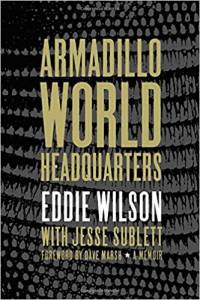 together anecdotes. He regarded Wilson’s book as somewhat self-serving. Hattersley, obviously more of an insider than me, worked as a bouncer and a bartender. He has long gathered information for his own history of the old joint at 525½ Barton Springs Road in south Austin.
together anecdotes. He regarded Wilson’s book as somewhat self-serving. Hattersley, obviously more of an insider than me, worked as a bouncer and a bartender. He has long gathered information for his own history of the old joint at 525½ Barton Springs Road in south Austin.
As for Wilson, I met him a few times at Threadgill’s—more on that later—and once at a taping of Austin City Limits. He had the intelligence, drive and charisma needed to found and sustain Texas’ greatest music hall. The cavernous AWHQ opened on August 7, 1970 and closed in the early-morning hours of January 1, 1981. During that time, I (1) recovered from major back surgery, (2) graduated from Bryan Adams High School, (3) attended UT for seven semesters and Stephen F. Austin State University for one, (4) moved to Dallas, (5) moved to Lexington, Kentucky, (6) escaped the clutches of a very zealous girlfriend, (7) spent a few months in suburban Detroit, (8) moved to Durham, North Carolina, (9) moved to Denton and (10) wasted valuable time, as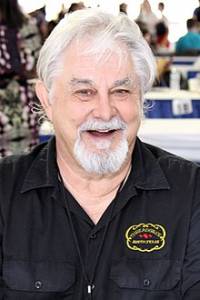 young people are wont to do. I returned to Austin six months after the Dillo closed, by which time it had already encountered the wrecking ball.
young people are wont to do. I returned to Austin six months after the Dillo closed, by which time it had already encountered the wrecking ball.
I will skip the standard line about Armadillo World Headquarters being where hippies and conservatives learned to get along, appreciating each other’s music, both groups partaking of Lone Star longnecks and marijuana splifs. Cosmic cowboys and redneck rockers? Please. I never bought this gross oversimplification because in fact all sorts of people attended concerts there—some of whom did not drink or take drugs. And let it be remembered that more than country and rock & roll music was played at the Dillo. Blues, jazz, folk, western swing, punk, Tejano, gospel, soul and other eclectica (ballet! magic shows!) filled the schedule during those 10-plus years.
The Armadillo, a real purveyor of Texas culture just a couple of miles south of the UT campus, meant a lot to me. But I look back and wonder why I did not go more often. Never did I sit in the beer garden in the shade of that huge oak tree. I attended no more than 10 concerts, the ones I remember being Boz Scaggs, Roy Buchanan, Loudon Wainwright III, Pavlov’s Dog and the aforementioned Greezy 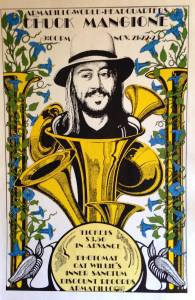 Wheels. I never saw Freddie King, although he played there countless times. I could have and should paid a few bucks—admission was always cheap—to see Taj Mahal, ZZ Top, Bruce Springsteen, Papa John Creach, the Police, Willie Nelson, Jimmy Cliff or other such acts. The building, erected as an armory in the late 1940s, had room for 1,500 spectators.
Wheels. I never saw Freddie King, although he played there countless times. I could have and should paid a few bucks—admission was always cheap—to see Taj Mahal, ZZ Top, Bruce Springsteen, Papa John Creach, the Police, Willie Nelson, Jimmy Cliff or other such acts. The building, erected as an armory in the late 1940s, had room for 1,500 spectators.
Were I sufficiently motivated and somewhat cooler, I might have been one of the numerous young European-Americans who wanted to be part of the Dillo scene, working in some backup capacity or just pitching in. Help was always needed at this venue which was not a money-maker in the best of times. It would have been interesting.
I must make reference to the creative artwork done by such men as Jim Franklin, Micael Priest, Ken Featherston, Kerry Awn and Guy Juke. Their designs were on the outside and inside of the building (including a mural of Big Rikkie, the Guacamole Queen), but most of all they adorned flyers posted on the Drag and all over central Austin. I admit to having confiscated a large number of them in 1976 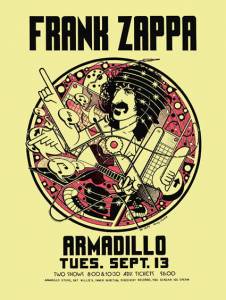 and stapled them to the wall of my one-room apartment on West 29th Street (75$ a month, all bills paid). Seventy-six, the year of the American bicentennial, was when I climbed into my blue Ford station wagon and drove a few miles north on Lamar Boulevard. As I have written elsewhere, I bought a can of spray paint at a nearby convenience store and hastily scrawled “Janis sang here” on the front wall of the old Threadgill’s service station. That’s where Janis Joplin had sung as a folkie before heading off to her wailing, moaning, hard-rock destiny in San Francisco. Wilson would soon buy the place and fix it up, so there is at least a tenuous connection between the Dillo and Threadgill’s. Wilson put it this way on page 391 of his book: “The people in charge of preserving Austin landmarks didn’t come rushing to the aid of the Armadillo in 1980, nor did their hearts beat in sympathy for Threadgill’s place in the 1970s. But some soul with a heart for history and a can of spray paint had written ‘Janis sang here’ on the side of the derelict building.”
and stapled them to the wall of my one-room apartment on West 29th Street (75$ a month, all bills paid). Seventy-six, the year of the American bicentennial, was when I climbed into my blue Ford station wagon and drove a few miles north on Lamar Boulevard. As I have written elsewhere, I bought a can of spray paint at a nearby convenience store and hastily scrawled “Janis sang here” on the front wall of the old Threadgill’s service station. That’s where Janis Joplin had sung as a folkie before heading off to her wailing, moaning, hard-rock destiny in San Francisco. Wilson would soon buy the place and fix it up, so there is at least a tenuous connection between the Dillo and Threadgill’s. Wilson put it this way on page 391 of his book: “The people in charge of preserving Austin landmarks didn’t come rushing to the aid of the Armadillo in 1980, nor did their hearts beat in sympathy for Threadgill’s place in the 1970s. But some soul with a heart for history and a can of spray paint had written ‘Janis sang here’ on the side of the derelict building.”
While Wilson was undoubtedly the central figure in the history of the Dillo, others deserve recognition. How about Hank Alrich, an Austin guy who grasped the value of what was aborning and twice made $25,000 loans? Sports writer Bud Shrake also wrote a few checks when times were lean. I had never heard of Mike Tolleson or Bobby Hedderman before reading Wilson’s book, but they gave a lot of themselves. An exhausted Wilson left the Dillo in 1976, and it was soon in Chapter 11, fending off creditors left and right. It limped along a few more years, but the city was changing. Rents were going up. Every 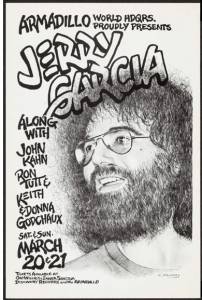 possible idea was tried to keep it alive, even going to billionaire attorney Joe Jamail, a prominent UT donor. He might have bought the property, put it into a trust of some kind and ensured its long-term health; Jamail declined to get involved. On New Year’s Eve 1980, the final concert featured Commander Cody and His Lost Planet Airmen, Asleep at the Wheel, Maria Muldaur and that yodeling master, Kenneth Threadgill. It lasted until sunrise of the first day of 1981. With that, AWHQ died a peaceful death.
possible idea was tried to keep it alive, even going to billionaire attorney Joe Jamail, a prominent UT donor. He might have bought the property, put it into a trust of some kind and ensured its long-term health; Jamail declined to get involved. On New Year’s Eve 1980, the final concert featured Commander Cody and His Lost Planet Airmen, Asleep at the Wheel, Maria Muldaur and that yodeling master, Kenneth Threadgill. It lasted until sunrise of the first day of 1981. With that, AWHQ died a peaceful death.
You can have your Cavern Club (Liverpool), your Fillmore East (New York’s Lower East Side), your George’s Majestic Lounge (Fayetteville, Arkansas) your Apollo Theater (Harlem), your Ryman Auditorium (Nashville), your Hollywood Bowl (Los Angeles), your Cain’s Ballroom (Tulsa) and your Paradise Rock Club (Boston), some of which are still extant. I am sure they all have/had their own ambience, things that endear(ed) them to locals. I’ll take the Armadillo, which has now been gone for nearly 40 years.

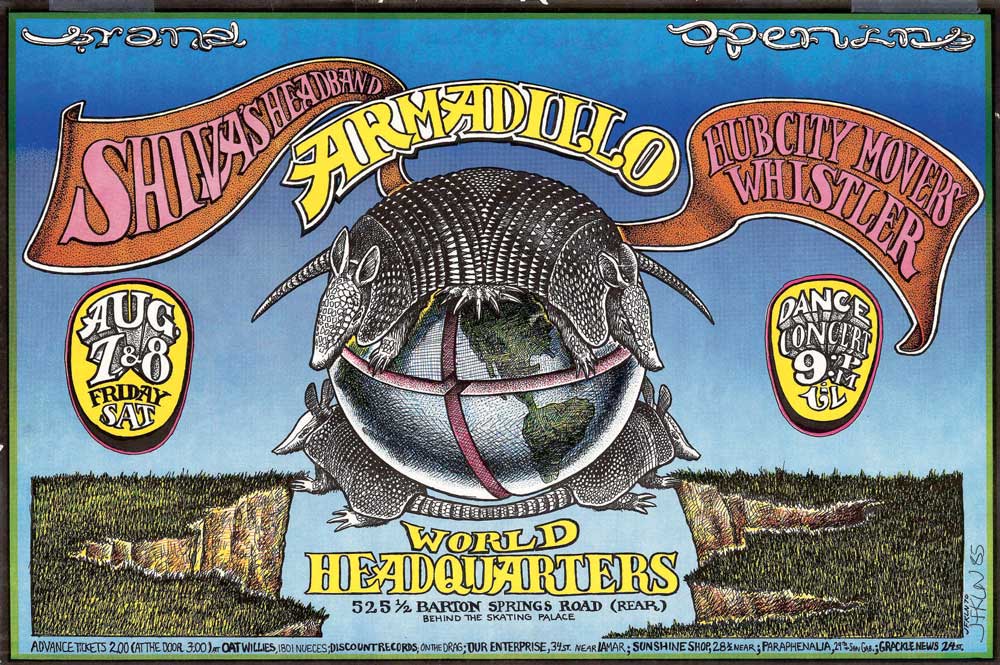
6 Comments
Richard, the Armadillo is so rich in history. So many musicians of renown have played and entertained. Very fascinating place indeed. I am glad you wrote about it. I never went there but having read your story, it should have been on my bucket list.
Well, as I say in the article it is strange how important it is to me now…and yet at the time, I didn’t go too often. I wish Jamail or the city would have seen the value of this place and backed it.
I never went there, no money for stuff like that back then! I remember hearing about it but I was into rock and roll, Foghat, etc. That music didn’t interest me. I have seen Kerry Awn at Esthers Follies many times, interesting connection!
Kenny: I can see how Foghat would have preferred a bigger arena than the Dillo. Then again, some big names played there just because of the “cool” cachet.
Interesting, Richard, I had not heard of the ‘Dillo. You know where I was in the 70’s, and it wasn’t in Austin! I saw that was a much different Jim Franklin than the one we knew at BA. Cheers, Kevin
Yes, same name but different guys…
Add Comment